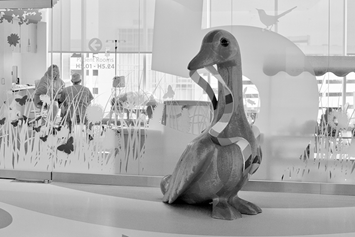Jeune's Syndrome
Jeune's Syndrome is a form of congenital dwarfism, causing children to have a deformity of their chest wall.
What Is Jeune's Syndrome?
Jeune's Syndrome is a form of congenital dwarfism causing children to have a deformity of their chest wall. The chest cage is extremely small and doesn't have enough room for proper breathing. The ribs are broad, short and irregularly joined between the cartilage and sternum, or breastbone. This produces a bell-shaped, inflexible chest cavity, which doesn't grow well in time. Without treatment, children with severe cases of Jeune's will slowly, and progressively, run out of room to breathe.
If your child has been diagnosed with Jeune's Syndrome or related chest wall conditions, you are most likely filled with countless questions, concerns and likely every other kind of emotion. The goal of this section is to give you a general overview about the condition. Once you have reviewed this section, visit the Medical Tutorial section of our site to find more about Jeune's related chest wall conditions, as well as our surgical and non-surgical approach to treatment.
What Are the Symptoms of Jeune's Syndrome?
A child with Jeune's may have symptoms as early as a newborn, or as late as 4-5 years of age. Depending on the progression of the disease, respiratory symptoms can range from mild to severe. A mild symptom includes a slightly rapid breathing rate where a more severe form can include recurrent pneumonia. The most severe form may cause the inability to breathe without help from a breathing machine, or ventilator.
A child with Jeune's Syndrome is typically small in overall size and may have liver or kidney disease in addition. Children who have more mild symptoms often respond well to treatment that is aimed at ongoing medical support of their lungs.
How Is Jeune's Syndrome Treated?
Depending on the child's particular symptoms, treatment may include prompt antibiotics for infection, proper mobilization of secretions, supplemental oxygen, BiPap, non-invasive ventilator (or breathing) support or other forms of respiratory therapy. For more severe cases, Nationwide Children's Hospital has devised a method for expanding the chest cavity that has created hope for many children who previously had few options.
Nationwide Children's cares for one of the largest groups of Jeune's Syndrome patients in the world. For those patients who need it, we have developed a procedure that expands the thoracic cavity. This procedure appears to hold out hope of longevity and improved quality of life in several children.
The foundation of Nationwide Children's Hospital's approach to treating severe cases of Jeune's Syndrome lies in the fact that the chest cavity does not allow proper breathing room and additional space must be created within the thoracic area. We became involved with Jeune's when we learned of a patient activist group in 1992 seeking a facility that would undertake surgical treatment of this rare disease. After thorough assessments and scrupulous research, we began to formulate a procedure that we believe would be effective.
Treatment for all Jeune's patients begins with a series of tests by our multidisciplinary team of Jeune's specialists. Less severe cases of Jeune's are typically then treated with various forms of medical support for the lungs. Severe cases normally require surgery. Our unique surgical procedure expands both the left and right sides of the chest, which eventually allows for the type of room needed for breathing. It is a two-stage procedure, which involves linking the ribs together with titanium struts, as well as creating more of a chest wall by sliding out the rib from the underlying rib bed.
Since 1993, our thoracic surgery, pulmonary medicine and plastic surgery teams have combined their skills. Our results have been extremely successful in patients older than two years of age. Of seven patients who were two years or older, we have seen significant clinical improvement. Several cases have shown a measurable increase in lung capacity. Patients who present in the first year or two of life have a more severe form of the problem and may have underlying lung disease which cannot be helped with simple expansion of the chest wall. On the other hand, we have had success in this age group if the lungs are normal. A new technique in CT imaging has improved our ability to define the anatomy of the lungs and rib cage in infants, as well as provide useful pre-operative information.
We are careful to emphasize to all parents that while Nationwide Children's has had some of the largest experience to date treating Jeune's, this remains largely unknown territory. Our procedure however, has proven to do well and improve quality of life in appropriate children. We continue to offer the procedure to appropriate patients and add even more to the useful lifetime of these patients.



